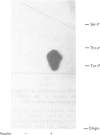Abstract
Catecholamine treatment of isolated rat adipocytes decreases insulin binding and inhibits insulin stimulation of the glucose-transport system. There is increasing evidence that the insulin signal is transmitted after insulin is bound to the receptor via a tyrosine kinase, which is an intrinsic part of the receptor. To find whether the receptor kinase is modified by catecholamines, we solubilized and partially purified the insulin receptor of isoprenaline-treated adipocytes and studied the effect of insulin on its kinase activity. (1) Insulin increased the tyrosine autophosphorylation of the insulin receptor kinase from catecholamine-treated cells only 4-fold, compared with a 12-fold stimulation in control cells. (2) The rate of insulin-stimulated 32P incorporation into the receptor of isoprenaline-treated cells at non-saturating [32P]ATP concentrations (5 muM) was decreased to 5-8% of the values for receptor from control cells. (3) 125I-insulin binding to the partially purified receptor from catecholamine-treated cells was also markedly decreased. The insulin receptor from catecholamine treated cells bound 25-50% of the amount of insulin bound by the receptor from control cells at insulin concentrations of 10 pM-0.1 muM. Part of the impaired insulin-responsiveness of the receptor kinase of catecholamine-treated cells is therefore explained by impaired binding properties; however, an additional inhibition of the kinase activity of the insulin receptor from catecholamine-treated cells is evident. (4) This inhibition of kinase activity decreased when the concentration of [gamma-32P]ATP in the phosphorylation assay was increased. A Lineweaver-Burk analysis revealed that the Km for ATP of the receptor kinase from isoprenaline-treated cells was increased to approx. 100 muM, compared with approx. 25 muM for receptor of control cells. (5) We conclude from the data that catecholamine treatment of rat adipocytes modulates the kinase activity of the insulin receptor by increasing its Km for ATP and that this is part of the mechanism leading to insulin-resistance in these cells.
Full text
PDF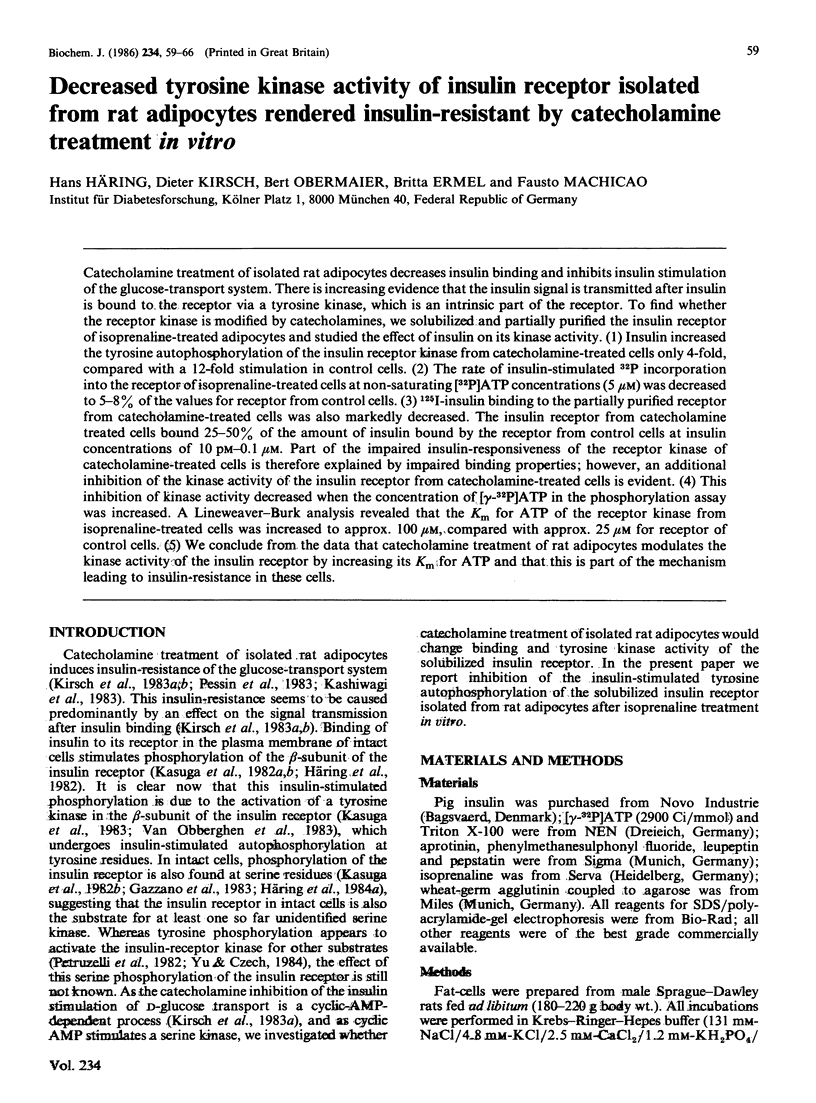
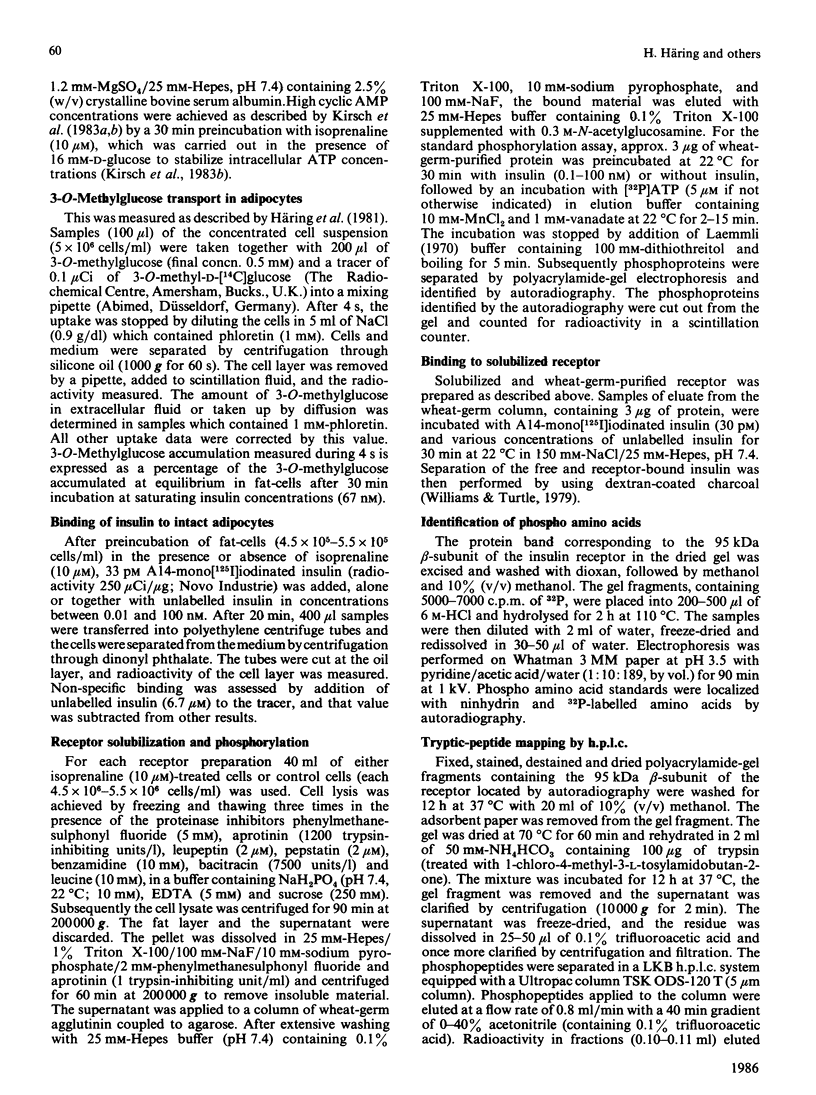
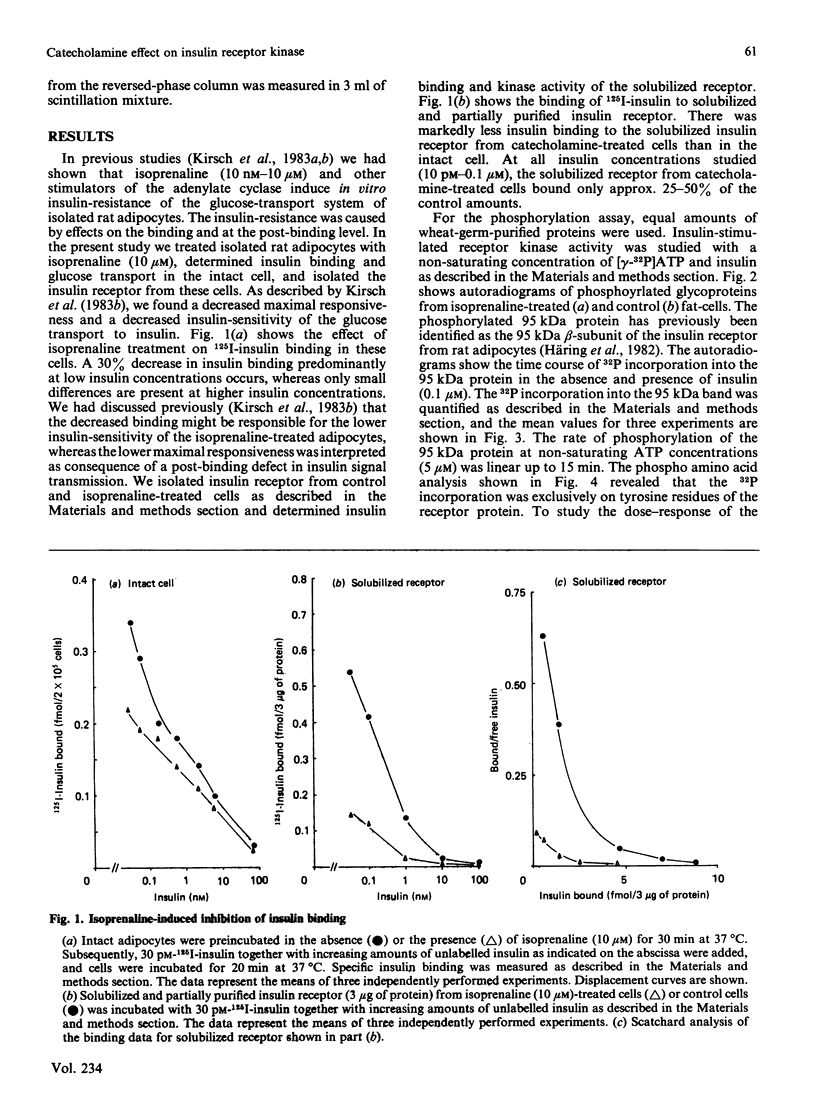
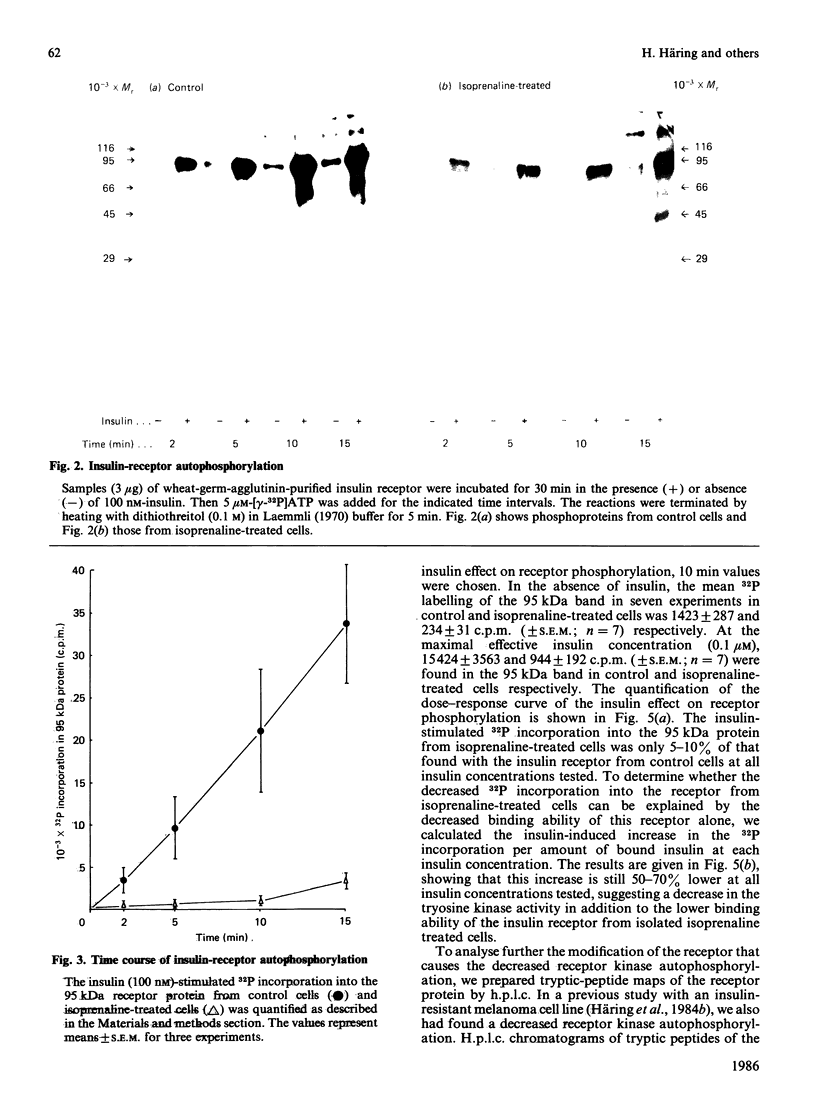
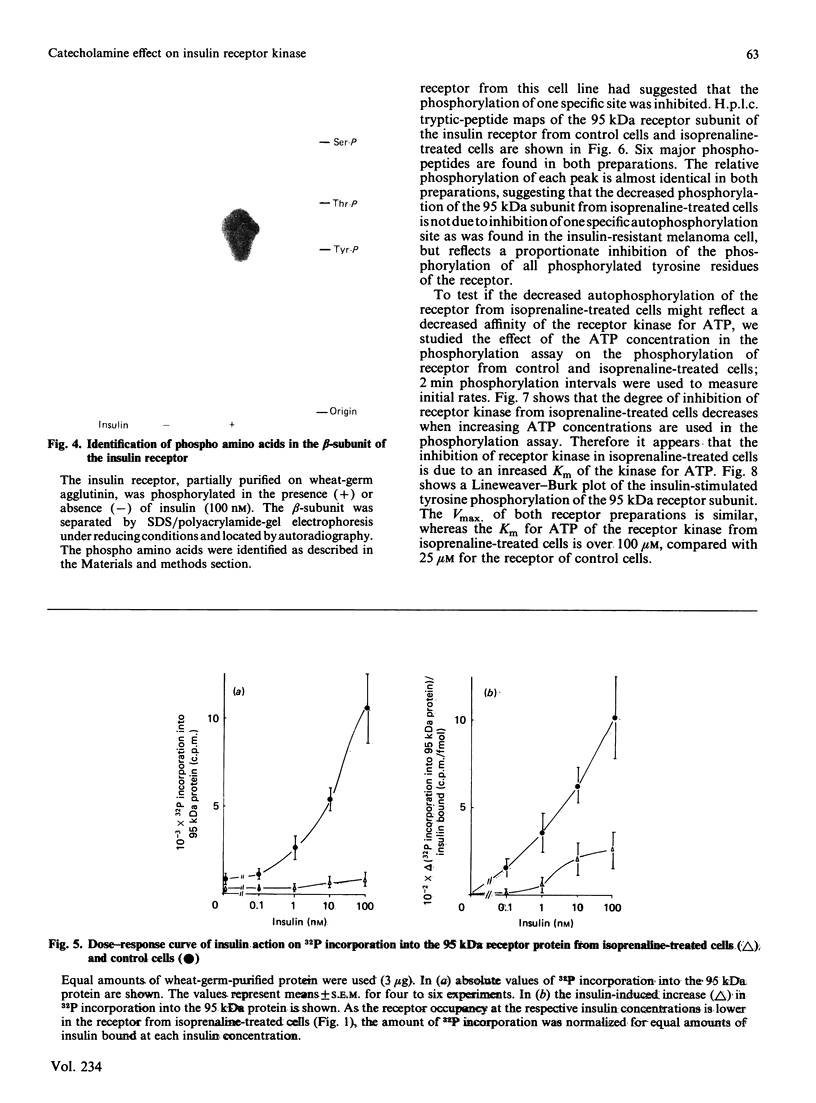
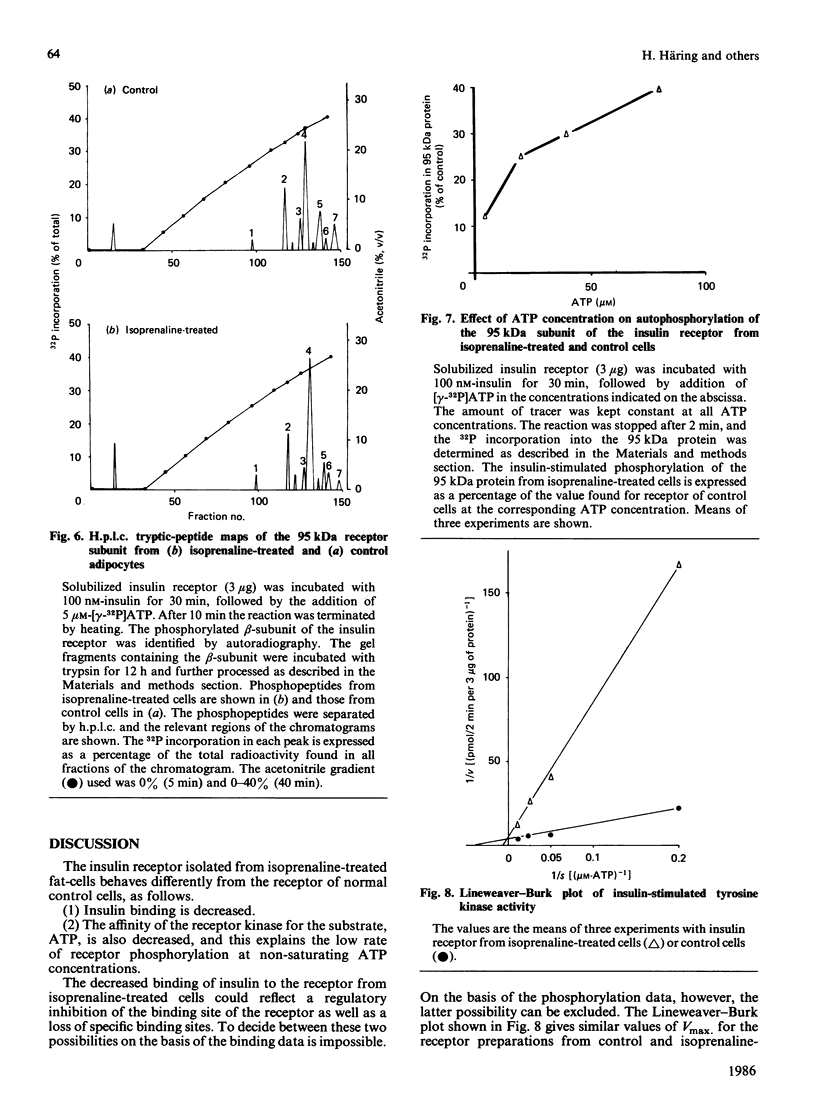
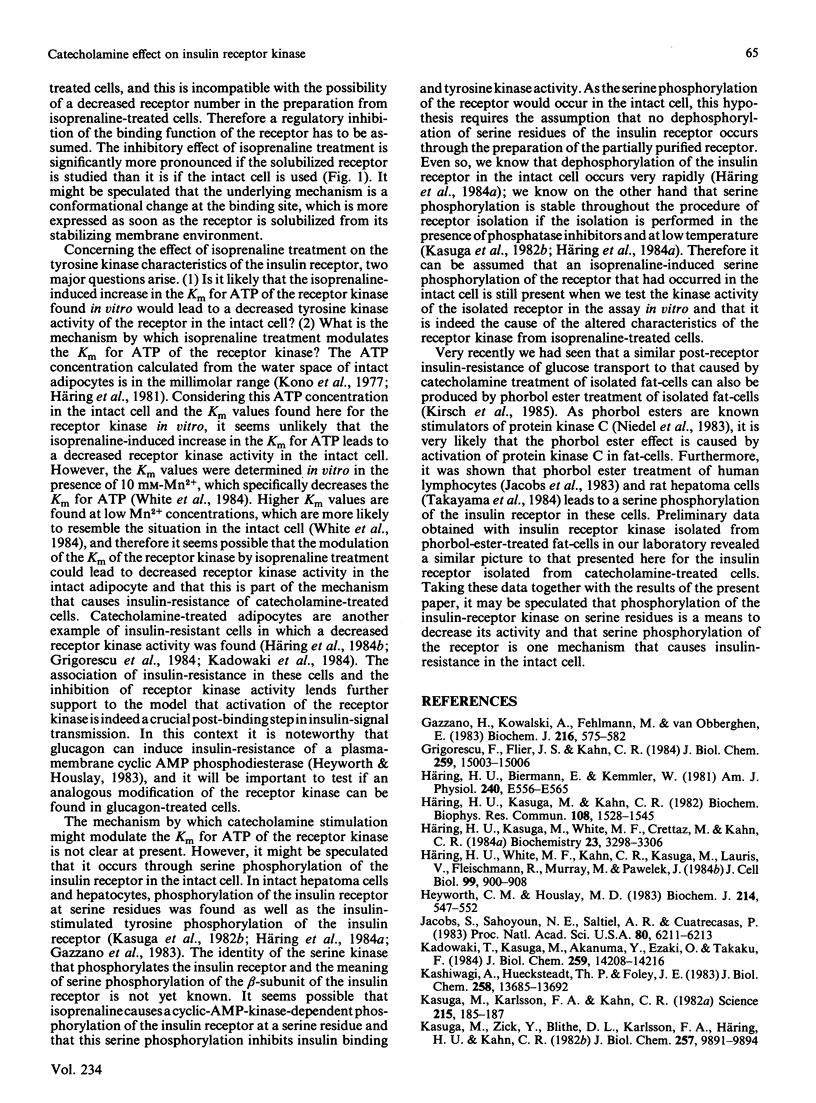
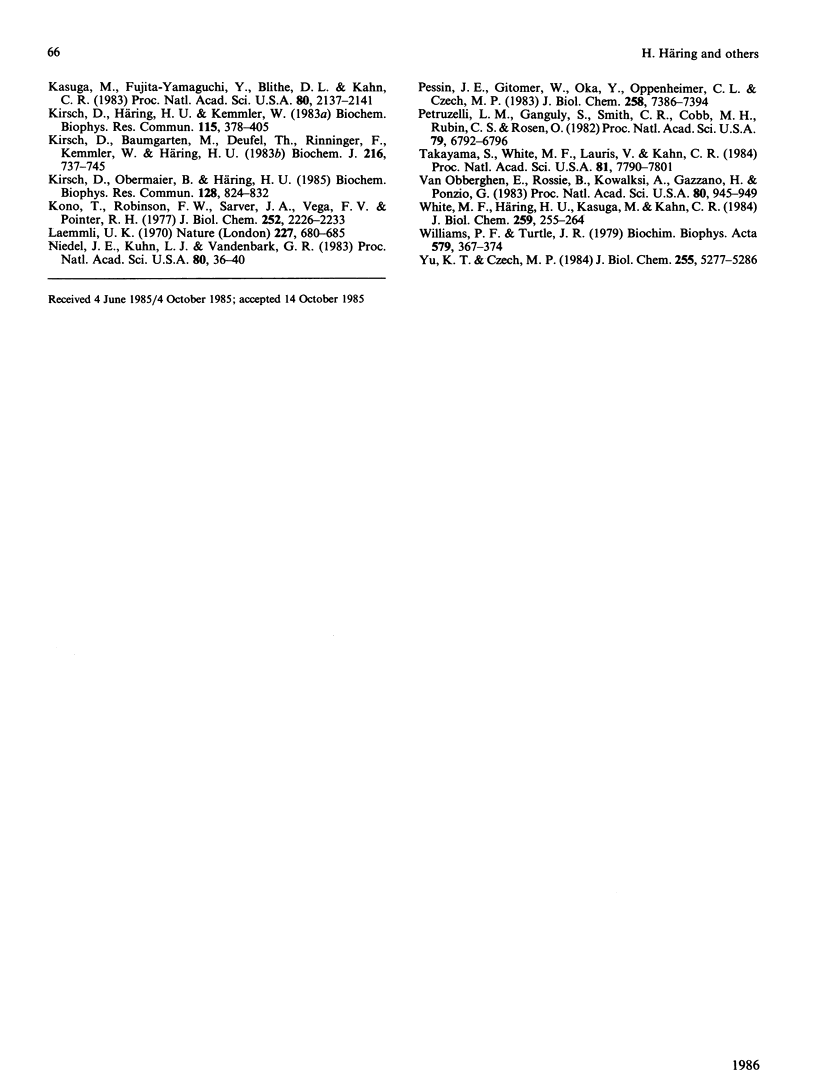
Images in this article
Selected References
These references are in PubMed. This may not be the complete list of references from this article.
- Gazzano H., Kowalski A., Fehlmann M., Van Obberghen E. Two different protein kinase activities are associated with the insulin receptor. Biochem J. 1983 Dec 15;216(3):575–582. doi: 10.1042/bj2160575. [DOI] [PMC free article] [PubMed] [Google Scholar]
- Grigorescu F., Flier J. S., Kahn C. R. Defect in insulin receptor phosphorylation in erythrocytes and fibroblasts associated with severe insulin resistance. J Biol Chem. 1984 Dec 25;259(24):15003–15006. [PubMed] [Google Scholar]
- Haring H. U., Kasuga M., White M. F., Crettaz M., Kahn C. R. Phosphorylation and dephosphorylation of the insulin receptor: evidence against an intrinsic phosphatase activity. Biochemistry. 1984 Jul 3;23(14):3298–3306. doi: 10.1021/bi00309a028. [DOI] [PubMed] [Google Scholar]
- Haring H. U., White M. F., Kahn C. R., Kasuga M., Lauris V., Fleischmann R., Murray M., Pawelek J. Abnormality of insulin binding and receptor phosphorylation in an insulin-resistant melanoma cell line. J Cell Biol. 1984 Sep;99(3):900–908. doi: 10.1083/jcb.99.3.900. [DOI] [PMC free article] [PubMed] [Google Scholar]
- Heyworth C. M., Houslay M. D. Insulin exerts actions through a distinct species of guanine nucleotide regulatory protein: inhibition of adenylate cyclase. Biochem J. 1983 Aug 15;214(2):547–552. doi: 10.1042/bj2140547. [DOI] [PMC free article] [PubMed] [Google Scholar]
- Häring H. U., Biermann E., Kemmler W. Coupling of insulin binding and insulin action on glucose transport in fat cells. Am J Physiol. 1981 May;240(5):E556–E565. doi: 10.1152/ajpendo.1981.240.5.E556. [DOI] [PubMed] [Google Scholar]
- Häring H. U., Kasuga M., Kahn C. R. Insulin receptor phosphorylation in intact adipocytes and in a cell-free system. Biochem Biophys Res Commun. 1982 Oct 29;108(4):1538–1545. doi: 10.1016/s0006-291x(82)80082-x. [DOI] [PubMed] [Google Scholar]
- Jacobs S., Sahyoun N. E., Saltiel A. R., Cuatrecasas P. Phorbol esters stimulate the phosphorylation of receptors for insulin and somatomedin C. Proc Natl Acad Sci U S A. 1983 Oct;80(20):6211–6213. doi: 10.1073/pnas.80.20.6211. [DOI] [PMC free article] [PubMed] [Google Scholar]
- Kadowaki T., Kasuga M., Akanuma Y., Ezaki O., Takaku F. Decreased autophosphorylation of the insulin receptor-kinase in streptozotocin-diabetic rats. J Biol Chem. 1984 Nov 25;259(22):14208–14216. [PubMed] [Google Scholar]
- Kashiwagi A., Huecksteadt T. P., Foley J. E. The regulation of glucose transport by cAMP stimulators via three different mechanisms in rat and human adipocytes. J Biol Chem. 1983 Nov 25;258(22):13685–13692. [PubMed] [Google Scholar]
- Kasuga M., Fujita-Yamaguchi Y., Blithe D. L., Kahn C. R. Tyrosine-specific protein kinase activity is associated with the purified insulin receptor. Proc Natl Acad Sci U S A. 1983 Apr;80(8):2137–2141. doi: 10.1073/pnas.80.8.2137. [DOI] [PMC free article] [PubMed] [Google Scholar]
- Kasuga M., Zick Y., Blith D. L., Karlsson F. A., Häring H. U., Kahn C. R. Insulin stimulation of phosphorylation of the beta subunit of the insulin receptor. Formation of both phosphoserine and phosphotyrosine. J Biol Chem. 1982 Sep 10;257(17):9891–9894. [PubMed] [Google Scholar]
- Kirsch D. M., Baumgarten M., Deufel T., Rinninger F., Kemmler W., Häring H. U. Catecholamine-induced insulin resistance of glucose transport in isolated rat adipocytes. Biochem J. 1983 Dec 15;216(3):737–745. doi: 10.1042/bj2160737. [DOI] [PMC free article] [PubMed] [Google Scholar]
- Kirsch D., Kemmler W., Häring H. U. Cyclic AMP modulates insulin binding and induces post-receptor insulin resistance of glucose transport in isolated rat adipocytes. Biochem Biophys Res Commun. 1983 Aug 30;115(1):398–405. doi: 10.1016/0006-291x(83)91017-3. [DOI] [PubMed] [Google Scholar]
- Kirsch D., Obermaier B., Häring H. U. Phorbolesters enhance basal D-glucose transport but inhibit insulin stimulation of D-glucose transport and insulin binding in isolated rat adipocytes. Biochem Biophys Res Commun. 1985 Apr 30;128(2):824–832. doi: 10.1016/0006-291x(85)90121-4. [DOI] [PubMed] [Google Scholar]
- Kono T., Robinson F. W., Sarver J. A., Vega F. V., Pointer R. H. Actions of insulin in fat cells. Effects of low temperature, uncouplers of oxidative phosphorylation, and respiratory inhibitors. J Biol Chem. 1977 Apr 10;252(7):2226–2233. [PubMed] [Google Scholar]
- Laemmli U. K. Cleavage of structural proteins during the assembly of the head of bacteriophage T4. Nature. 1970 Aug 15;227(5259):680–685. doi: 10.1038/227680a0. [DOI] [PubMed] [Google Scholar]
- Niedel J. E., Kuhn L. J., Vandenbark G. R. Phorbol diester receptor copurifies with protein kinase C. Proc Natl Acad Sci U S A. 1983 Jan;80(1):36–40. doi: 10.1073/pnas.80.1.36. [DOI] [PMC free article] [PubMed] [Google Scholar]
- Pessin J. E., Gitomer W., Oka Y., Oppenheimer C. L., Czech M. P. beta-Adrenergic regulation of insulin and epidermal growth factor receptors in rat adipocytes. J Biol Chem. 1983 Jun 25;258(12):7386–7394. [PubMed] [Google Scholar]
- Petruzzelli L. M., Ganguly S., Smith C. J., Cobb M. H., Rubin C. S., Rosen O. M. Insulin activates a tyrosine-specific protein kinase in extracts of 3T3-L1 adipocytes and human placenta. Proc Natl Acad Sci U S A. 1982 Nov;79(22):6792–6796. doi: 10.1073/pnas.79.22.6792. [DOI] [PMC free article] [PubMed] [Google Scholar]
- Takayama S., White M. F., Lauris V., Kahn C. R. Phorbol esters modulate insulin receptor phosphorylation and insulin action in cultured hepatoma cells. Proc Natl Acad Sci U S A. 1984 Dec;81(24):7797–7801. doi: 10.1073/pnas.81.24.7797. [DOI] [PMC free article] [PubMed] [Google Scholar]
- Van Obberghen E., Rossi B., Kowalski A., Gazzano H., Ponzio G. Receptor-mediated phosphorylation of the hepatic insulin receptor: evidence that the Mr 95,000 receptor subunit is its own kinase. Proc Natl Acad Sci U S A. 1983 Feb;80(4):945–949. doi: 10.1073/pnas.80.4.945. [DOI] [PMC free article] [PubMed] [Google Scholar]
- White M. F., Haring H. U., Kasuga M., Kahn C. R. Kinetic properties and sites of autophosphorylation of the partially purified insulin receptor from hepatoma cells. J Biol Chem. 1984 Jan 10;259(1):255–264. [PubMed] [Google Scholar]
- Williams P. F., Turtle J. R. Purification of the insulin receptor from human placental membranes. Biochim Biophys Acta. 1979 Aug 28;579(2):367–374. doi: 10.1016/0005-2795(79)90064-3. [DOI] [PubMed] [Google Scholar]
- Yu K. T., Czech M. P. Tyrosine phosphorylation of the insulin receptor beta subunit activates the receptor-associated tyrosine kinase activity. J Biol Chem. 1984 Apr 25;259(8):5277–5286. [PubMed] [Google Scholar]




